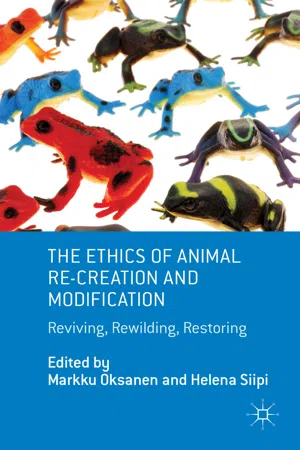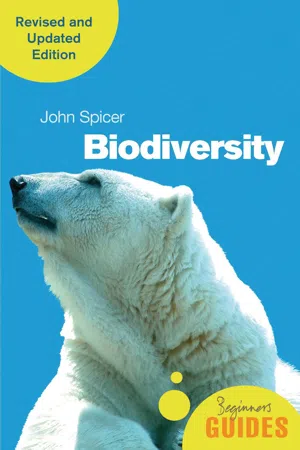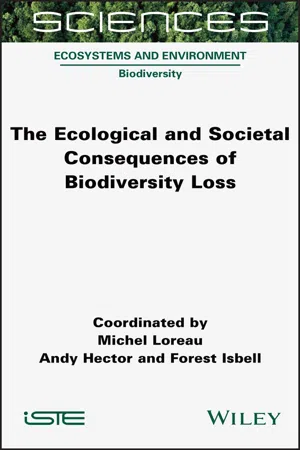Human Impact on Biodiversity
Human impact on biodiversity refers to the negative effects of human activities on the variety and abundance of living organisms in a given area. This includes habitat destruction, pollution, overexploitation of natural resources, and the introduction of invasive species. These activities can lead to a loss of biodiversity, disrupting ecosystems and threatening the balance of natural systems.
7 Key excerpts on "Human Impact on Biodiversity"
- eBook - ePub
Biodiversity
An Introduction
- Kevin J. Gaston, John I. Spicer(Authors)
- 2013(Publication Date)
- Wiley-Blackwell(Publisher)
...5 Human impacts 5.1 Introduction Although it is essential to humankind, brings innumerable benefits, and has other important values, humans have had strong negative impacts on biodiversity. Indeed, whilst over geological time the general trend has been towards an overall net increase in biodiversity, the late Quaternary has been a period of marked decline, as both a direct and indirect consequence of human activities. This decline comprises all those changes that are associated with reducing or simplifying biological heterogeneity, from genes to ecosystems. In this chapter we consider the negative human impacts on biodiversity, concentrating particularly on the loss of species. First, we address the level of those losses (Sections 5.2 & 5.3). Second, we examine the four principal proximate causes of the losses, namely overexploitation, habitat loss and degradation, introduced species, and extinction cascades (Section 5.4). Third, we consider the ultimate causes of the impacts of humans on biodiversity, namely the size of the human population, the growth in that population, and the scale of the human enterprise (Section 5.5). 5.2 Species extinctions The best-known and most widely discussed impact of human activities on biodiversity has been that of the extinction of species. The loss of species seems to capture the public imagination, perhaps because of its irreversibility and the extraordinary nature of some of those species that have met their demise. In addition, species extinctions constitute the obvious, as well as a genuinely useful, barometer of change in biodiversity when this is measured in terms of species richness. 5.2.1 Prehistoric times The impacts of humankind on other species have lasted for a long time, probably for much of the 100,000–200,000 years for which anatomically modern humans have existed...
- eBook - ePub
- Brian Dawson, Matt Spannagle(Authors)
- 2008(Publication Date)
- Routledge(Publisher)
...BIODIVERSITY IMPACTS Biodiversity is a term used to describe the variability that exists between organisms, species, and ecosystems. Although 1.6 million species have been documented to date, it is estimated that the total number of species on earth could be as many as 30 million. 1 The earth’s biodiversity changes constantly as new species emerge and others disappear. Biodiversity is also concentrated in specific areas, particularly tropical rainforests. Scientists have identified 32 biodiversity hotspots that contain over half the world’s known species, but covering only 2% of the earth’s surface. 2 Based on studies of the earth’s biological history, it is estimated that the natural average rate of emergence and disappearance of species is around three per year. 3 This rate has not been constant, with some periods being characterized by rapid increases in biodiversity and others featuring mass extinctions. Changes in prevailing climatic conditions due to fluctuations in solar activity and long-term variations in the earth’s orbit (see Milankovich cycles), periods of intense volcanic activity, and cataclysmic meteorite strikes have been important determinants of biodiversity change in the past. The current rate of species extinction is well above the natural background rate. 4 Currently, 25% of the world’s mammals and 12% of birds are at risk of extinction. 5 This is largely due to human activities such as deforestation, urban development, pollution, overgrazing, desertification, damming of rivers, overexploitation of species, and a host of other major disturbances...
- eBook - ePub
Population, Agriculture, and Biodiversity
Problems and Prospects
- J. Perry Gustafson, Peter H. Raven, Paul R. Ehrlich(Authors)
- 2020(Publication Date)
- University of Missouri(Publisher)
...A recent assessment of projected land uses suggested that, by 2040, more than a thousand threatened species may lose a majority of their habitat (Pouzols et al., 2014). A global analysis of conflict zones between biodiversity and food security goals identified several key areas like Madagascar and the Peruvian Andes (Molotoks et al., 2017). These areas and others emphasize the need for interdisciplinary approaches by a diversity of disciplines including agro-ecologists, conservation scientists, and social scientists focused on understanding food demand and cultivation practices to minimize, mitigate, and predict possible adverse effects of agricultural production on biodiversity and the environment. These studies and many others also emphasize the need to understand these risks at a local level. Here, we discuss three case studies exemplifying harmful effects of current and expanding agriculture. We discuss both indirect impacts of agricultural activity, human wildlife conflict, and the direct impact of habitat loss. The first case is a discussion of human wildlife conflict in savanna Africa. The second and third cases, focusing on habitat loss, discuss the Mata Atlântica of Brazil and the expansion of oil palm cultivation across the global tropics, respectively. Crucially, even in areas where agricultural expansion does not result in species extinctions it may affect local populations in a way that alters overall community structure. One classic example of this is the increase in white-tailed deer populations (Odocoileus virginianus) throughout the eastern United States. Deer are habitat generalists and easily adapt to vegetation changes. They benefit from local population declines and extirpations of predators including puma (Puma concolor) and gray wolves (Canis lupus)...
- eBook - ePub
The Ethics of Animal Re-creation and Modification
Reviving, Rewilding, Restoring
- M. Oksanen, H. Siipi, M. Oksanen, H. Siipi(Authors)
- 2014(Publication Date)
- Palgrave Macmillan(Publisher)
...8 Biodiversity and the Value of Human Involvement Markku Oksanen Introduction Resurrecting an extinct animal species and releasing it into the wild is intentional human activity that increases biodiversity – or does it? Over the millennia, humans have played an important role in shaping the natural world by means of selecting and harvesting biological resources, creating new varieties and, disputably, new species (such as the dog) and manipulating the physical environment of their own and other organisms. The resulted forms of diversity are often fully dependent on humans. Many researchers have, however, been very reluctant to count human-dependent diversity as an element of overall biodiversity (for example Angermeier 1994). Theoretically, this reluctance rests on the assumption that there is a divide between the genuinely natural world with natural forms of life and the world brought about, or essentially modified, by human beings. Accordingly, there exists two kinds of biological diversity: (1) the variety of life that has been generated from nature’s own forces and the evolutionary process of speciation; (2) the variety of life that has come into existence in virtue of, or has benefited from, human activities and, moreover, whose existence depends on these activities. Therefore, as far as this separation holds and the human-dependent diversity does not count, the resurrection of extinct species lacks an important justificatory foundation: resurrected animal species are not a welcome addition to the shrinking diversity of animals. A major task in environmental philosophy – particularly in the early days of its development in the 1970s and 1980s – has been to highlight the value of the part of nature that is not affected by humans at all or where human impact is minimal. Despite the historical disregard for the issue, the justification of the value of human-produced and human-dependent biodiversity is relevant to environmental ethical theory...
- eBook - ePub
- Colin G. Scanes, Samia Toukhsati(Authors)
- 2017(Publication Date)
- Academic Press(Publisher)
...Also, there can be shifts in food supply. 19.7. Other Human Impacts of Habitats There are other effects of human activity from habitat loss, degradation, or fragmentation. Examples of these include the following: • Dams for hydroelectric power and flood control negatively influence breeding grounds for fish. • Pollutants degrading habitats. For instance, polychlorinated biphenyls bioaccumulate in marine mammals, such as harbor seals (Phoca vitulina), which are at the top of the food chain (Park et al., 2009). • The ecologically fragile Florida Everglades (Fig. 19.10) is vulnerable to the effects of climate change (Catano et al., 2015) and the invasive species, the Burmese python (discussed in Section 17.4.1). • The development of a man-made lake and opening of a habitat for human recreation was accompanied by declines in populations of North American wood turtles (Clemmys insculpta) (Garber and Burger, 1995). • Human activity can influence the number of animals by causing disturbance. For instance, the number of sharks was reported to be lower in areas of the Great Barrier Reef that were fished compared with “no entry” or “no take” areas (McCook et al., 2010). It is assumed that this reflects shifts in the number of fish eaten by the sharks (McCook et al., 2010). Figure 19.10 The Everglades in Florida (USA) are ecologically fragile with habitats is danger of destruction. (A) Wild turkeys in the Everglades National Park. (B) Alligator in the Everglades National Park. (C) Egret in the Everglades National Park. (D) Seagrass meadows on the western edge of the Everglades providing nutrition to many animal species. Source: Part A and C: Courtesy US National Parks Service; part B: Courtesy US National Parks Service; photo by Karen Battle-Sanborn; part D: Courtesy US National Parks Service; photo by Justin Campbell. 19.8. Conclusions Clearly, human activity is leading to habitat loss, habitat degradation, and habitat fragmentation...
- eBook - ePub
Biodiversity
A Beginner's Guide (revised and updated edition)
- John Spicer(Author)
- 2021(Publication Date)
- Oneworld Publications(Publisher)
...5 Swept away and changed Animals may dig holes to live in; may weave nests or take possession of hollow trees… They make little impression on the world. But the world is furrowed and cut, torn and blasted by man. Its flora has been swept away and changed…its flat lands littered by the debris of his living. John Steinbeck, The Log from the Sea of Cortez Threatening behaviour San Diego has been touted as the most biologically rich county in the continental US…and the most threatened. Two hundred species of animals and plants are currently considered endangered, more than in any other county. If I asked you what the present threats to San Diego’s biodiversity are, or even those to biodiversity in the area where you live, what would you say? Is it increasing development, change of land use leading to loss of habitat, increasing pollution, introduced pests, or competition for resources? And is this the same if we are thinking on a global scale? In this chapter we explore a number of direct (or proximate) causes (Fig. 20), going through them one by one, asking ourselves how significant each is. It will also be helpful to discuss the extent to which they explain past extinctions, and if unabated, contribute to future ones. Whatever turn out to be the most important direct threats, we must look at what drives them in the first place, the indirect or ultimate threat. So we will finish with some discussion of the magnitude of the ultimate cause of current extinctions – that’s you and me. Figure 20 How we threaten biodiversity. Living beyond our means The 2016 Living Planet Report, published by the World Wildlife Fund, assessed our impact on the planet by examining what biodiversity is present and how we are using it. Figure 21 is based on that report. It shows our ecological footprint, the ratio between the world’s demand for natural resources and the world’s biocapacity (resource supply, expressed as number of Earths), for each year from 1961 to 2016...
- Michel Loreau, Andy Hector, Forest Isbell(Authors)
- 2022(Publication Date)
- Wiley-ISTE(Publisher)
...What distinguishes the ecosystem approach is its focus on the system as a whole, often without considering the species that compose it. At a time when humankind is rising to the status of a major global biogeochemical force and raising the prospect of a global ecological crisis, it is important to step back and ask whether individually studying communities and ecosystems is the best path to follow. Human environmental impacts include the destruction and fragmentation of natural habitats, pollution, climate change, overexploitation of biological resources, homogenization of biota, and biodiversity loss. These impacts affect species and ecosystems indistinctly. Moreover, they interact with each other, which may lead to synergistic effects. For instance, climate change is likely to cause massive additional biodiversity loss. Biodiversity loss in turn is likely to decrease the ability of ecosystems to resist the effects of climate change, with possible feedbacks on the climate system itself. Species, communities, and ecosystems have always been inextricably linked, but the major disruptions generated by humans in the current period make this reality plainly obvious. A synthetic approach to ecology, which integrates populations, communities, and ecosystems, is required to develop appropriate responses to the global ecological crisis we are entering. Community ecology is a dynamic field of research in which knowledge has accumulated rapidly during the last 60 years or so based largely on a modern hypothetico-deductive approach. However, theories and hypothesis building have often outpaced empirical studies and hypothesis testing in community ecology, which hinders steady scientific progress. As a result, this subdiscipline has few “laws” or robust generalizations, except for some large-scale empirical patterns such as species–area relationships (Rosenzweig 1999). In contrast, ecosystem ecology is a subdiscipline that has traditionally had a strong empirical basis...






